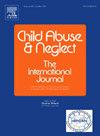Documentation of child neglect: Do assessment tools make a difference?
IF 3.4
2区 心理学
Q1 FAMILY STUDIES
引用次数: 0
Abstract
Background
Neglect is the most common form of child maltreatment and has serious consequences for the development of children. Assessing child neglect is challenging because it involves recognizing acts of omission rather than commissions. If situations of neglect are not documented adequately, protective measures may not be taken.
Objective
This study examines the influence of the assessment tool SAT-BL on the documentation of neglect. By including other assessment characteristics in the analysis, we aim to better understand what influences whether child neglect is documented or not in a case.
Participants and setting
Data from 319 assessment case files were analyzed in a case-control study. Case files from six different CPSs were included with assessments starting between 2016 and 2020.
Methods
Information was systematically collected from case files. Logistic regression models were constructed with documented child neglect as the dependent variable.
Results
Results showed that in cases assessed with the SAT-BL tool, neglect was documented significantly more (50 %) than when no tool was used (30.64 %). Regression analysis revealed a nearly four-times higher probability of documenting child neglect when using the assessment tool SAT-BL while controlling for other predictors. Other factors, such as documented risk factors, the number of professionals involved, conducted home visits and proposed child protection orders, also showed significant associations with neglect documentation.
Conclusion
Results of our analysis indicate that using an assessment tool with definitions increases documentation of child neglect. There is a need for definitions and thresholds when assessing child neglect.
儿童忽视的记录:评估工具有作用吗?
忽视是最常见的儿童虐待形式,对儿童的发展会产生严重后果。评估儿童忽视是具有挑战性的,因为它涉及到承认疏忽行为而不是委托。如果忽视的情况没有充分的文件记录,可能不会采取保护措施。目的探讨评估工具SAT-BL对忽视记录的影响。通过在分析中包括其他评估特征,我们的目标是更好地了解在一个案例中,是什么影响了儿童忽视是否被记录下来。在一项病例对照研究中分析了来自319个评估病例档案的参与者和环境数据。从2016年至2020年开始的评估中纳入了六个不同cps的病例档案。方法系统收集病例资料。以文献记载的儿童忽视为因变量,构建Logistic回归模型。结果结果显示,在使用SAT-BL工具评估的病例中,被忽视的病例(50%)明显多于未使用工具的病例(30.64%)。回归分析显示,在控制其他预测因素的情况下,使用评估工具SAT-BL记录儿童忽视的可能性高出近四倍。其他因素,如记录在案的风险因素、参与的专业人员数量、进行的家访和提议的儿童保护令,也显示出与忽视记录的显著关联。结论:我们的分析结果表明,使用带有定义的评估工具增加了儿童忽视的记录。在评估儿童忽视时,需要定义和阈值。
本文章由计算机程序翻译,如有差异,请以英文原文为准。
求助全文
约1分钟内获得全文
求助全文
来源期刊

Child Abuse & Neglect
Multiple-
CiteScore
7.40
自引率
10.40%
发文量
397
期刊介绍:
Official Publication of the International Society for Prevention of Child Abuse and Neglect. Child Abuse & Neglect The International Journal, provides an international, multidisciplinary forum on all aspects of child abuse and neglect, with special emphasis on prevention and treatment; the scope extends further to all those aspects of life which either favor or hinder child development. While contributions will primarily be from the fields of psychology, psychiatry, social work, medicine, nursing, law enforcement, legislature, education, and anthropology, the Journal encourages the concerned lay individual and child-oriented advocate organizations to contribute.
 求助内容:
求助内容: 应助结果提醒方式:
应助结果提醒方式:


